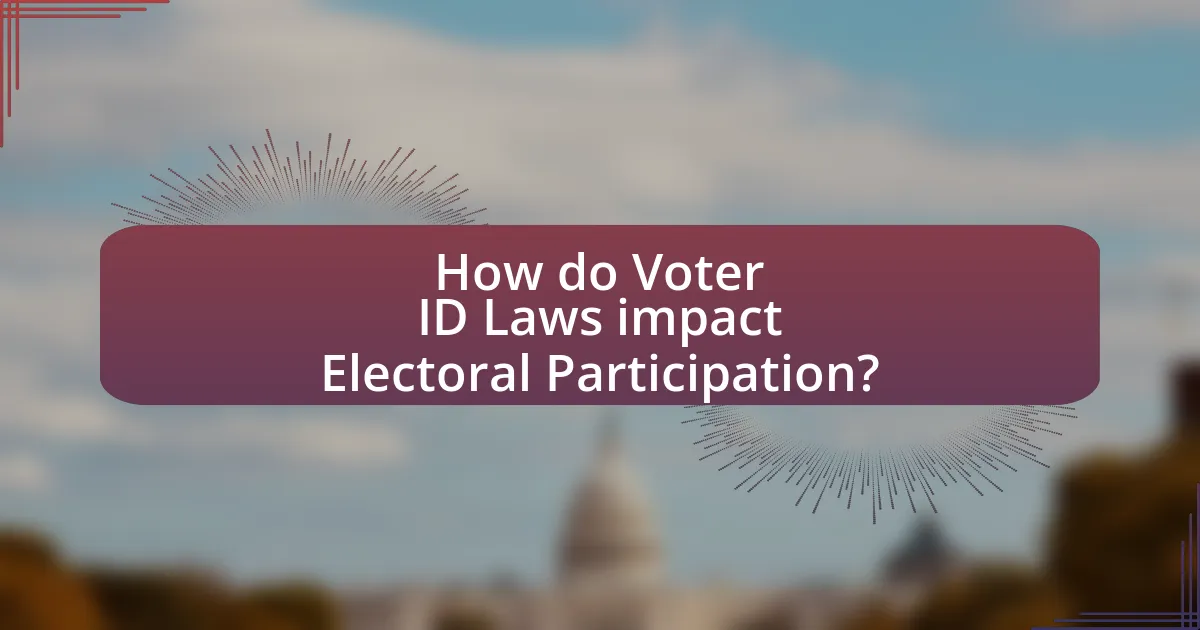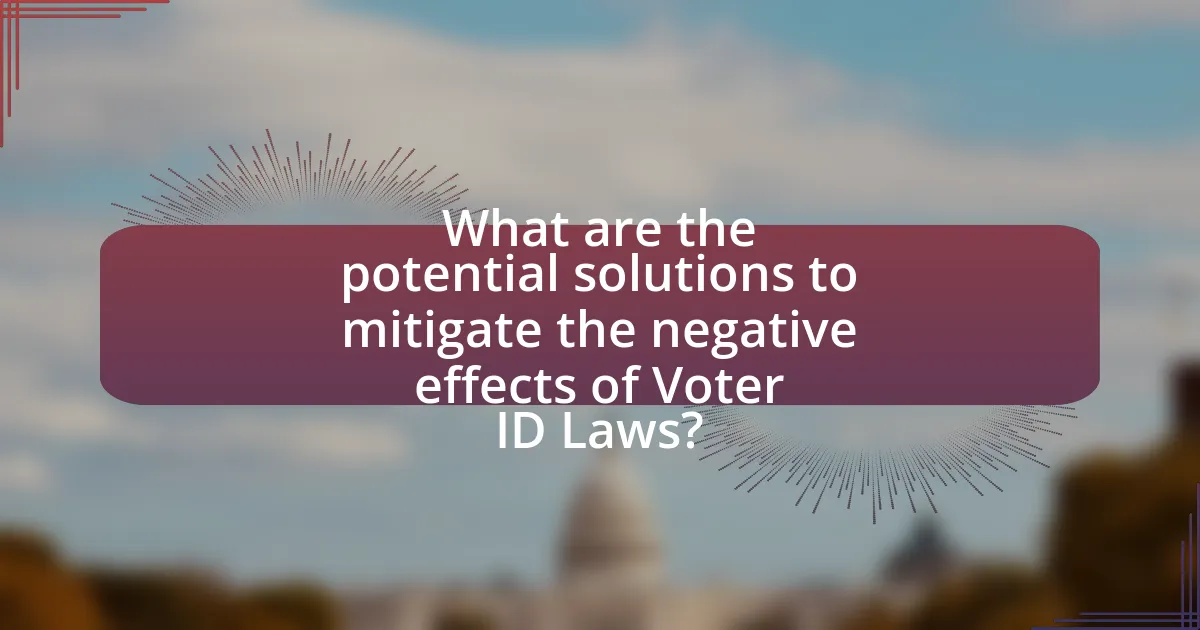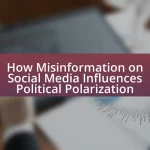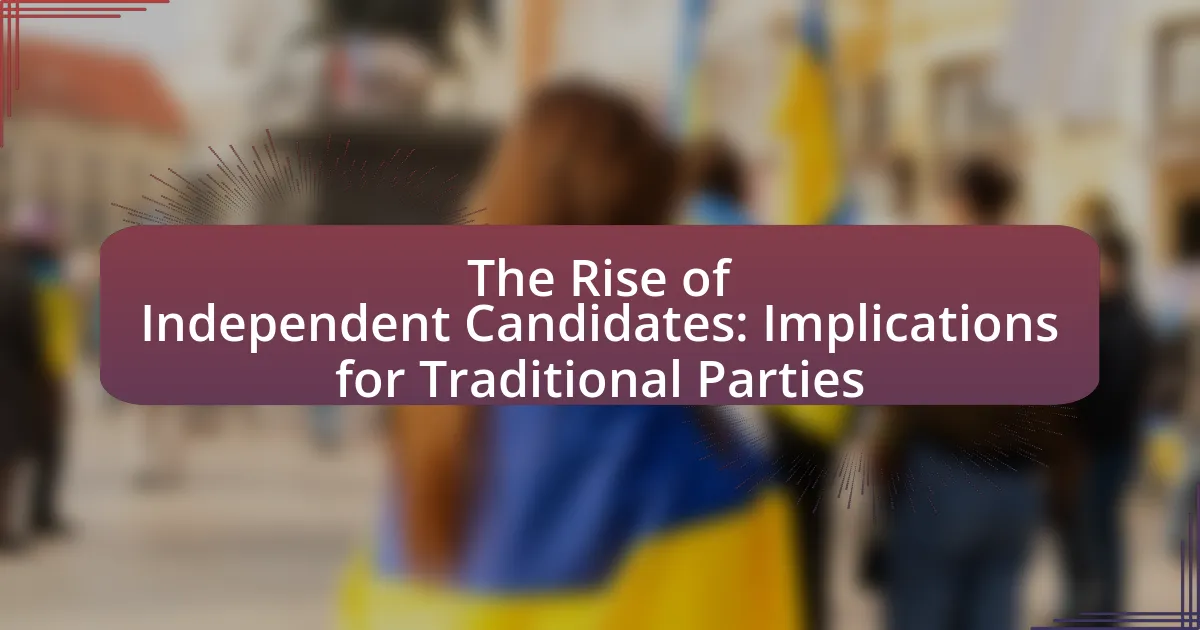Voter ID laws are regulations requiring individuals to present specific forms of identification before voting, aimed at preventing voter fraud and ensuring election integrity. As of 2023, 35 states have enacted such laws, which vary significantly in their requirements, with some states enforcing strict photo ID mandates while others have no ID requirements at all. The article examines the arguments for and against these laws, highlighting their impact on electoral participation, particularly among marginalized groups. It discusses the evidence supporting the effectiveness of Voter ID laws in preventing fraud, as well as the criticisms regarding their potential to disenfranchise voters. Additionally, the article explores strategies to mitigate the negative effects of these laws and enhance voter participation.

What are Voter ID Laws and Their Purpose?
Voter ID laws are regulations that require individuals to present specific forms of identification before being allowed to vote. The primary purpose of these laws is to prevent voter fraud and ensure the integrity of elections. For instance, according to the National Conference of State Legislatures, as of 2023, 35 states have enacted laws requiring voters to show identification at the polls, reflecting a significant trend aimed at enhancing electoral security.
How do Voter ID Laws vary across different states?
Voter ID laws vary significantly across different states in the U.S., with some states requiring strict photo identification, while others accept non-photo forms of ID or have no ID requirements at all. For example, states like Georgia and Indiana enforce strict photo ID laws, mandating voters to present government-issued identification, whereas states like California and New York do not require any identification to vote. According to the National Conference of State Legislatures, as of 2023, 35 states have laws requesting or requiring voters to show identification at the polls, reflecting a diverse landscape of voter ID regulations that can impact electoral participation.
What are the common types of identification required by these laws?
Common types of identification required by voter ID laws include government-issued photo IDs, such as driver’s licenses, state ID cards, passports, and military IDs. These forms of identification are mandated to verify the identity of voters at polling places, ensuring that individuals casting ballots are eligible to vote. For instance, a study by the National Conference of State Legislatures indicates that 35 states have enacted laws requiring some form of identification, with photo IDs being the most common requirement.
Why do some states implement stricter ID requirements than others?
Some states implement stricter ID requirements than others due to varying political ideologies, concerns about voter fraud, and legislative priorities. For instance, states with Republican leadership often advocate for stricter ID laws, citing the need to ensure election integrity, while Democratic-led states typically emphasize accessibility and voter participation. According to a 2020 report by the Brennan Center for Justice, 35 states have enacted laws requiring voters to present identification, with stricter requirements often correlating with higher rates of voter suppression claims. This divergence reflects broader national debates on voting rights and the balance between security and accessibility in the electoral process.
What arguments are made in favor of Voter ID Laws?
Arguments in favor of Voter ID Laws include the assertion that they enhance the integrity of elections by preventing voter fraud. Proponents argue that requiring identification ensures that only eligible voters can cast ballots, thereby maintaining public confidence in the electoral process. For instance, a study by the National Conference of State Legislatures indicates that states with Voter ID laws report lower instances of voter impersonation, which is a common concern among supporters. Additionally, advocates claim that Voter ID laws promote accountability and transparency in elections, as they provide a verifiable method to confirm voter identity.
How do proponents believe Voter ID Laws enhance electoral integrity?
Proponents believe Voter ID Laws enhance electoral integrity by ensuring that only eligible voters can cast ballots, thereby reducing the risk of voter impersonation and fraud. They argue that requiring identification verifies a voter’s identity, which helps maintain accurate voter rolls and fosters public confidence in the electoral process. For instance, a study by the National Conference of State Legislatures indicates that states with strict voter ID laws report lower instances of alleged voter fraud, suggesting that these laws can deter fraudulent activities and enhance the overall security of elections.
What evidence supports the effectiveness of Voter ID Laws in preventing fraud?
Evidence supporting the effectiveness of Voter ID Laws in preventing fraud includes studies indicating a significant reduction in instances of voter impersonation. For example, a report by the National Commission on Election Administration found that states with strict voter ID laws experienced lower rates of reported fraud compared to those without such laws. Additionally, a study published in the journal “Election Studies” by authors like Michael P. McDonald and others demonstrated that voter ID laws correlate with a decrease in fraudulent activities, particularly in states that implemented these laws alongside comprehensive voter registration systems. These findings suggest that Voter ID Laws can serve as a deterrent to potential fraud, thereby enhancing the integrity of the electoral process.
What criticisms exist regarding Voter ID Laws?
Criticisms regarding Voter ID Laws primarily focus on their potential to disenfranchise voters, particularly among marginalized groups. Studies indicate that these laws disproportionately affect low-income individuals, racial minorities, and the elderly, who may lack the required identification. For instance, a 2014 study by the Government Accountability Office found that states with strict voter ID laws saw a decline in voter turnout, especially among minority populations, by as much as 2-3%. Additionally, critics argue that the incidence of voter impersonation, which these laws aim to prevent, is exceedingly rare, with a 2017 study by the Brennan Center for Justice revealing only 31 credible instances of impersonation out of over a billion votes cast in the U.S. from 2000 to 2014. These points highlight the contention that Voter ID Laws may create more barriers than they resolve, undermining the democratic process.
How do critics argue that Voter ID Laws suppress voter turnout?
Critics argue that Voter ID Laws suppress voter turnout by creating barriers that disproportionately affect certain demographics, particularly minorities, the elderly, and low-income individuals. These laws often require specific forms of identification that not all eligible voters possess, leading to disenfranchisement. For instance, a study by the Brennan Center for Justice found that approximately 11% of eligible voters do not have government-issued photo ID, with higher rates among African American and Latino populations. Additionally, the process of obtaining ID can be burdensome, involving costs, travel, and time, which further deters individuals from participating in elections.
What demographic groups are most affected by these laws?
Voter ID laws most significantly affect minority groups, low-income individuals, and the elderly. Research indicates that these demographic groups are less likely to possess the required forms of identification, which can lead to decreased electoral participation. For instance, a study by the Brennan Center for Justice found that approximately 25% of eligible voters in minority communities lack government-issued ID, compared to only 8% in white communities. Additionally, low-income individuals often face barriers in obtaining IDs due to costs and accessibility, while elderly voters may have difficulty accessing ID renewal services. These factors collectively contribute to lower turnout rates among these affected groups during elections.

How do Voter ID Laws impact Electoral Participation?
Voter ID laws generally decrease electoral participation, particularly among minority and low-income populations. Research indicates that states implementing strict voter ID requirements often see a reduction in voter turnout; for example, a study by the Brennan Center for Justice found that voter ID laws can reduce turnout by as much as 2-3% in some demographics. This decline is attributed to the barriers these laws create, such as the need for individuals to obtain specific forms of identification, which may not be readily accessible to everyone. Additionally, a report from the National Bureau of Economic Research highlighted that states with strict ID laws experienced significant drops in participation among eligible voters, particularly affecting those who are less likely to possess the required identification.
What evidence is there to suggest a correlation between Voter ID Laws and voter turnout?
Evidence suggests that stricter Voter ID laws correlate with decreased voter turnout, particularly among minority and low-income populations. Studies, such as the one conducted by the National Bureau of Economic Research in 2014, found that states implementing strict ID requirements saw a reduction in turnout by approximately 2-3 percentage points. Additionally, a 2016 analysis by the Brennan Center for Justice indicated that voter ID laws disproportionately affect African American and Latino voters, leading to significant barriers in accessing the polls. These findings collectively demonstrate a clear link between the implementation of Voter ID laws and reduced electoral participation.
How have voter turnout rates changed in states with strict ID laws?
Voter turnout rates in states with strict ID laws have generally decreased compared to states without such laws. Research indicates that strict voter ID laws can create barriers for certain demographics, particularly among minorities, the elderly, and low-income individuals, leading to lower participation rates. For example, a study by the National Bureau of Economic Research found that states implementing strict ID requirements saw a reduction in turnout by approximately 2-3 percentage points in elections. This evidence supports the conclusion that strict ID laws negatively impact voter participation.
What studies have been conducted to analyze this impact?
Several studies have been conducted to analyze the impact of voter ID laws on electoral participation. For instance, a comprehensive analysis by the National Bureau of Economic Research titled “The Effect of Voter ID Laws on Voter Turnout” by Stephen Ansolabehere and Eitan D. Hersh (2017) found that strict voter ID laws can lead to a decrease in voter turnout, particularly among minority groups. Additionally, a study published in the American Economic Journal by Thomas B. Holbrook and Jennifer A. Smith (2018) demonstrated that states with stringent ID requirements experienced a significant drop in participation rates compared to those without such laws. These studies provide empirical evidence that voter ID laws can negatively affect electoral participation, particularly among vulnerable populations.
What role does public perception play in the effectiveness of Voter ID Laws?
Public perception significantly influences the effectiveness of Voter ID laws by shaping voter attitudes and behaviors. When a majority of the public views Voter ID laws as necessary for election integrity, compliance rates among voters tend to increase, leading to higher participation. Conversely, if public perception leans towards viewing these laws as restrictive or discriminatory, it can result in decreased voter turnout, particularly among marginalized groups. Research from the Brennan Center for Justice indicates that states with stricter voter ID laws often see a decline in participation rates, especially among minority voters, highlighting the critical role that public sentiment plays in the actual impact of these laws on electoral participation.
How do voters’ beliefs about ID laws influence their likelihood to participate?
Voters’ beliefs about ID laws significantly influence their likelihood to participate in elections. When voters perceive ID laws as necessary for election integrity, they are more likely to engage in the electoral process, believing that their participation contributes to fair outcomes. Conversely, if voters view ID laws as restrictive or discriminatory, they may feel disenfranchised, leading to decreased participation rates. Research from the Brennan Center for Justice indicates that states with strict ID laws often see lower voter turnout, particularly among minority and low-income populations, who may lack the required identification. This correlation underscores how beliefs about the fairness and accessibility of ID laws directly impact voter engagement.
What misinformation exists regarding Voter ID Laws and their effects?
Misinformation regarding Voter ID Laws often claims that these laws significantly reduce voter turnout among minority groups and low-income individuals. However, studies, such as one conducted by the National Bureau of Economic Research, indicate that the impact of Voter ID laws on turnout is minimal, with some states showing no statistically significant decrease in participation rates. Additionally, claims that voter fraud is rampant and necessitates strict ID laws are misleading; research from the Brennan Center for Justice shows that in-person voter fraud is exceedingly rare, occurring at a rate of 0.0003% to 0.0025%. This evidence demonstrates that the narrative surrounding Voter ID laws often exaggerates their effects on electoral participation and misrepresents the prevalence of voter fraud.

What are the potential solutions to mitigate the negative effects of Voter ID Laws?
Potential solutions to mitigate the negative effects of Voter ID Laws include implementing alternative identification methods, enhancing public education campaigns, and providing free access to required identification. Alternative identification methods, such as allowing utility bills or bank statements as proof of identity, can help reduce barriers for voters who may lack government-issued IDs. Public education campaigns can inform citizens about the requirements and processes for obtaining IDs, thereby increasing awareness and participation. Additionally, providing free access to IDs through state-funded programs can alleviate financial burdens, ensuring that all eligible voters can participate in elections. These strategies have been shown to improve voter turnout in states with strict ID laws, as evidenced by studies conducted by the Brennan Center for Justice, which highlight the correlation between accessibility measures and increased electoral participation.
How can states balance security and accessibility in voting?
States can balance security and accessibility in voting by implementing measures such as risk-based voter ID laws that ensure both verification of identity and ease of access for eligible voters. For instance, states can offer multiple forms of identification, including non-photo IDs, and provide alternatives like signature matching or sworn affidavits for those unable to obtain ID. Research indicates that states with flexible voter ID laws, such as those allowing a wider range of identification options, experience higher voter turnout while maintaining security standards. A study by the Brennan Center for Justice found that overly strict voter ID laws can disenfranchise eligible voters, particularly among minority groups, thus highlighting the importance of a balanced approach that prioritizes both security and accessibility.
What alternative measures can be implemented to ensure electoral integrity?
To ensure electoral integrity, alternative measures such as implementing robust auditing processes, enhancing voter education programs, and utilizing technology for secure voting systems can be adopted. Robust auditing processes, including post-election audits, verify the accuracy of election results and have been shown to increase public confidence in electoral outcomes. For instance, a study by the Brennan Center for Justice highlights that states employing risk-limiting audits can detect and correct errors, thereby reinforcing electoral integrity. Additionally, enhancing voter education programs can inform citizens about the voting process, reducing misinformation and increasing participation. Finally, utilizing technology, such as blockchain for secure voting, can provide transparency and traceability, further ensuring that elections are conducted fairly and accurately.
How can education and outreach improve voter participation under ID laws?
Education and outreach can significantly improve voter participation under ID laws by informing citizens about the requirements and processes necessary to vote. Targeted educational campaigns can clarify what forms of identification are acceptable, how to obtain them, and the importance of voting, thereby reducing confusion and barriers to participation. For instance, studies have shown that states implementing voter education initiatives saw an increase in turnout; for example, a 2016 report by the Brennan Center for Justice indicated that states with proactive outreach efforts experienced higher voter engagement compared to those without such programs. By equipping voters with knowledge and resources, education and outreach can mitigate the disenfranchising effects of ID laws and encourage greater electoral participation.
What best practices can be adopted to enhance voter participation despite ID laws?
To enhance voter participation despite ID laws, implementing outreach programs that educate voters about ID requirements is essential. These programs can inform citizens about acceptable forms of identification and the process for obtaining them, thereby reducing confusion and barriers to voting. Research indicates that states with proactive voter education initiatives see higher participation rates; for example, a study by the Brennan Center for Justice found that states that provided clear information about ID laws experienced a 5% increase in voter turnout. Additionally, offering same-day registration and alternative verification methods can further facilitate access to the polls, ensuring that eligible voters are not disenfranchised by ID requirements.
How can community organizations assist voters in navigating ID requirements?
Community organizations can assist voters in navigating ID requirements by providing education, resources, and direct support. These organizations often conduct workshops to inform voters about specific ID laws in their state, including what forms of identification are acceptable and how to obtain them. For example, the Brennan Center for Justice reports that community groups have successfully increased voter participation by helping individuals understand and comply with ID requirements, particularly in states with strict laws. Additionally, organizations may offer assistance in obtaining necessary documents, such as birth certificates or government IDs, which can be barriers for some voters. By facilitating access to information and resources, community organizations play a crucial role in ensuring that voters can meet ID requirements and participate in elections.
What strategies can be employed to raise awareness about voter rights and ID laws?
To raise awareness about voter rights and ID laws, organizations can implement community education programs that provide clear information on these laws and their implications. These programs can include workshops, informational sessions, and distribution of educational materials that explain voter ID requirements and rights. Research indicates that states with proactive outreach efforts, such as those conducted by the League of Women Voters, see increased voter participation and understanding of ID laws. Additionally, leveraging social media campaigns can effectively reach a broader audience, as studies show that digital engagement significantly influences public awareness and mobilization efforts regarding voting rights.





